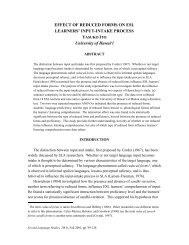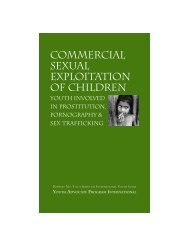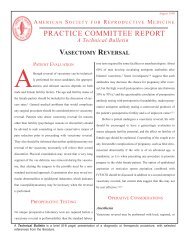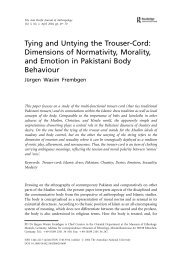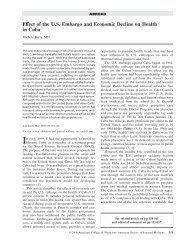Commercial Sexual Exploitation of Children: An Overview (PDF)
Commercial Sexual Exploitation of Children: An Overview (PDF)
Commercial Sexual Exploitation of Children: An Overview (PDF)
Create successful ePaper yourself
Turn your PDF publications into a flip-book with our unique Google optimized e-Paper software.
Vietnam and Cambodia have serious problems <strong>of</strong> child prostitution and trafficking, and<br />
Sri Lanka's sex industry has seen an explosive growth in recent years.38<br />
According to the U.S. Department <strong>of</strong> Justice, prostitution in the U.S. is growing<br />
dramatically among young people; the problem <strong>of</strong> teenage prostitution is particularly<br />
acute. In Europe, trafficking is increasing rapidly, and the ages <strong>of</strong> the women and girls<br />
involved are decreasing. The problem is particularly severe in the East European<br />
countries; Defense for <strong>Children</strong> International has reported an alarming growth <strong>of</strong><br />
prostitution among Russian, Polish, Romanian, Hungarian and Czech children. Trafficking<br />
routes are extending and there is evidence to suggest that children are trafficked across<br />
continents and into the sex industries <strong>of</strong> industrialized countries such as Japan, Australia<br />
and throughout Scandinavia. 39<br />
In Africa, many countries are faced with a rising child prostitution problem and the<br />
linkage with tourism is evident. Algeria has been reported as a place <strong>of</strong> transit for<br />
traffickers, and Senegal, Kenya, Sudan and Libya are on the list <strong>of</strong> countries where child<br />
prostitution is increasing. Visible increases <strong>of</strong> children in prostitution are noted in Ghana,<br />
Cote d'Ivoire and Burkina Faso.<br />
In Central and South America, there are large numbers <strong>of</strong> street children and the link<br />
between that and prostitution is strong. Child victims <strong>of</strong> sexual exploitation are present in<br />
large numbers in Nicaragua, Venezuela, Bolivia, Chile, Ecuador, and Peru. In Brazil,<br />
UNICEF estimates that the number <strong>of</strong> prostituted children exceeds 500,000. The average<br />
age is 13-17, but there are cases <strong>of</strong> children as young as six documented in Brazil.40<br />
Concerns have been raised regarding the visible increase in child sex workers in<br />
Honduras, El Salvador, Mexico, Costa Rica, Panama, Guatemala and Argentina.<br />
International Efforts<br />
The international community is paying increased attention to the commercial sexual<br />
exploitation <strong>of</strong> children, and transnational and international governing bodies are<br />
involved in combating the problem.41 International conventions treat child prostitution<br />
as an unacceptable form <strong>of</strong> forced labor; the aim is to eradicate the practices and to find<br />
the right strategies to prevent problems from occurring in the first place. A number <strong>of</strong><br />
initiatives have been taken to protect the human rights <strong>of</strong> children, specifically ending<br />
prostitution, preventing gender discrimination, and providing children with rights.<br />
There is growing international acceptance <strong>of</strong> the need for more effective action and<br />
strengthened law enforcement in the countries <strong>of</strong> destination to which sex <strong>of</strong>fenders<br />
come.42 Extra-territoriality laws on the part <strong>of</strong> the countries <strong>of</strong> origin are being<br />
implemented to penalize the conduct <strong>of</strong> their nationals who commit crimes against<br />
children in other countries.43Inmost cases, in both international and national law, the<br />
legal stance is that the sale and trafficking in children, child prostitution and the sexual<br />
exploitation <strong>of</strong> children, pedophilia and child pornography are all violent crimes against<br />
children and are treated as such.44 How effectively these duties are carried out depends<br />
on the extent to which the society regards the protection <strong>of</strong> children as important; the<br />
legal environment reflects the political environment, and unless a society gives priority to<br />
the protection <strong>of</strong> its children, the laws will not protect them.45 In reality, child victims<br />
are <strong>of</strong>fered little or no protection as many laws suffer from lax or weak enforcement. The<br />
child victim is commonly penalized, while there are few consequences for the <strong>of</strong>fender.<br />
Non-governmental organizations have been instrumental in broadening international<br />
dialogue and expanding consensus for greater action. The International Labor<br />
Organization (ILO) and the United Nations have been at the forefront in the development<br />
<strong>of</strong> instruments to prevent child exploitation and forced labor. In 1959, the United Nations<br />
Declaration on the Rights <strong>of</strong> the Child proclaimed that "the child shall be protected<br />
against all forms <strong>of</strong> neglect, cruelty and exploitation. The child shall not be subject to<br />
traffic in any form." The most significant development with regard to protection <strong>of</strong><br />
children is the establishment <strong>of</strong> the United Nations Convention on the Rights <strong>of</strong> the Child<br />
in 1989, outlining children's human rights in civil, political, economic and cultural terms -<br />
- the child's right to survival and development.46




